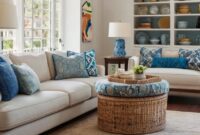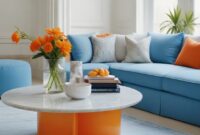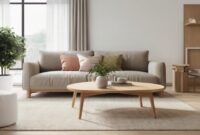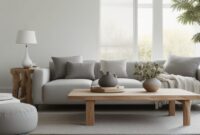Imagine a coffee table that’s not just functional, but a conversation starter, a piece of art for your living room, enter the live edge coffee table. A unique and stunning addition to any home.
Live edge tables are crafted from slabs of wood with their natural edges preserved, showcasing the organic form of the tree. Each table is one-of-a-kind, boasting the wood’s character – its knots, swirls, and variations in grain. This creates a sense of connection to nature, bringing the beauty of the outdoors into your living space.
Variety of Wood Types for Live Edge Coffee Tables
Live edge coffee tables come in a stunning array of wood types, each offering its own unique character, color, and grain pattern. Here are some of the most popular choices:
1. Black Walnut
A luxurious and sought-after wood, black walnut boasts a rich, dark brown color with beautiful contrasting lighter sapwood streaks. It’s incredibly strong, durable, and develops a warm patina over time.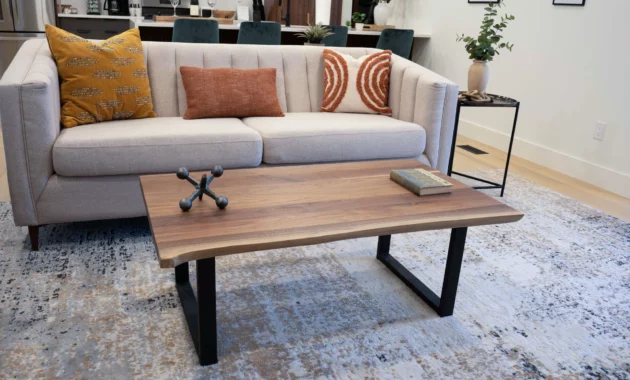
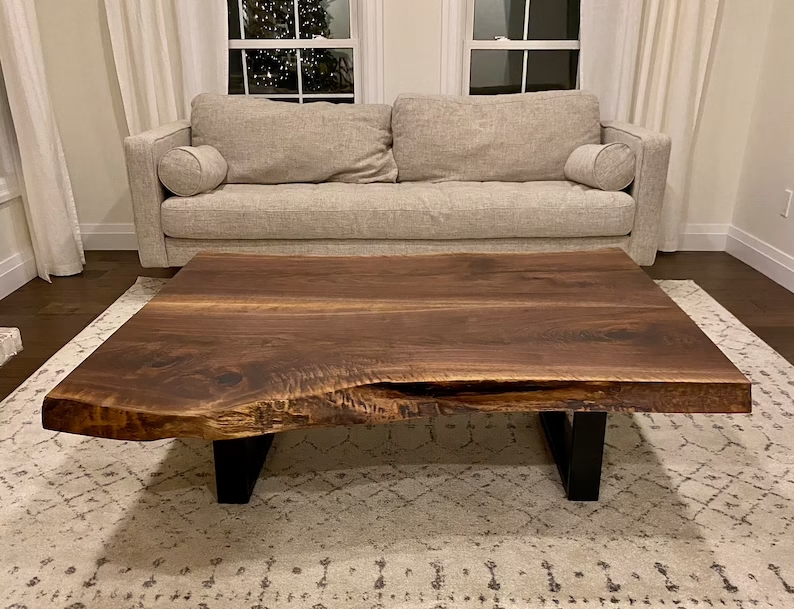
Good Wood Brothers Custom Made Black Walnut Live Edge Coffee Tables are carefully handcrafted and make for a beautiful centrepiece in any living room or office space.
2. Maple
Maple is a versatile wood that comes in a variety of lighter tones, from creamy white to a light golden brown. It features a tight, straight grain with occasional chatoyancy (iridescence) and is known for its clean and modern aesthetic.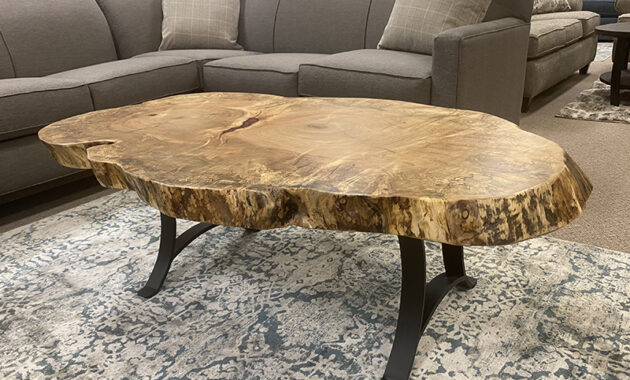
3. Oak
A classic choice for furniture, oak is a strong and affordable wood with a warm, golden brown color. It has a prominent, more rustic grain pattern with dramatic figuring and a flecked appearance.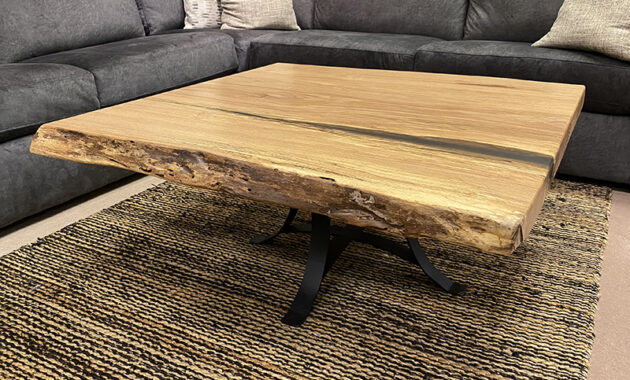
4. Cherry
Cherry offers a warm reddish-brown color that deepens and darkens with age. It has a fine, closed grain with a beautiful, satiny luster. Cherry is a popular choice for those who want a touch of warmth and richness in their living room.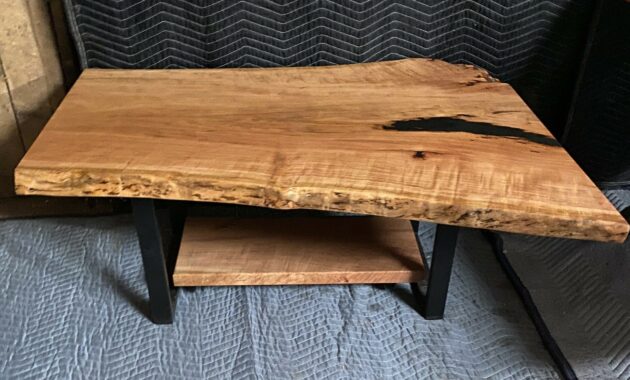
Mahogany: A rich reddish-brown wood with a beautiful grain pattern, known for its durability and resistance to warping.
Elm: A unique wood with a light to medium brown color and a swirling, interlocked grain.
Acacia: An exotic hardwood with a warm golden brown to reddish-brown color and a very tight grain pattern, offering exceptional durability.
Mango: A fruitwood with a beautiful golden color that can vary from light to deep. It has a distinctive grain pattern with swirling figures and chatoyancy.
Read also: 1. Rustic Wood Coffee Table: Bring Warmth and Character to Your Space 2. Small Apartment Living: Stylish Scandinavian Coffee Table for Tiny Spaces 3. Tiny House Interior: maximize space & Style in Your Tiny Home
Pros and Cons Live Edge Coffee Table
| No | Pros | Cons |
|---|---|---|
| 1 | Natural Beauty: Live edge wood coffee tables showcase the raw, natural beauty of wood, with unique grain patterns and irregular edges that add character to any space. | Cost: Live edge wood coffee tables can be more expensive compared to mass-produced tables due to the labor-intensive process of preserving the natural edges and craftsmanship involved. |
| 2 | One-of-a-Kind: Each live edge wood coffee table is unique, making it a statement piece that adds a distinctive touch to your home decor. | Limited Availability: Each live edge wood piece is unique, which means finding the perfect table that fits your specifications and preferences may require more time and effort. |
| 3 | Warmth and Texture: The warmth of wood and the texture of live edges create a cozy and inviting atmosphere in any room, adding a touch of rustic charm. | Maintenance: Wood requires regular maintenance, including polishing, waxing, and occasional refinishing to maintain its appearance and durability, which can be time-consuming. |
| 4 | Conversation Starter: The uniqueness of live edge wood coffee tables often sparks conversation, making them a focal point in social gatherings or family gatherings. | Vulnerability to Damage: Live edge wood tables are more susceptible to scratches, dents, and moisture damage compared to tables with sealed edges, requiring careful handling and protection. |
| 5 | Versatility: Live edge wood coffee tables can complement a variety of interior design styles, from rustic and farmhouse to modern and contemporary. | Weight: Solid wood live edge coffee tables can be heavy and cumbersome to move, making rearranging furniture or relocation more challenging. |
| 6 | Connection to Nature: Incorporating natural elements like wood into your living space can promote a sense of connection to nature, enhancing overall well-being. | Uneven Surfaces: The irregular edges of live edge wood tables may create uneven surfaces, making it difficult to place items like drinks or decor securely without wobbling. |
| 7 | Longevity: High-quality live edge wood coffee tables are durable and can last for generations with proper care, making them a worthwhile investment. | Style Limitations: While live edge wood coffee tables can complement various design styles, they may not suit every aesthetic preference, limiting their compatibility with certain decor schemes. |
Frequently Asked Questions (FAQs)
1. What is a live edge wood coffee table?
2. What types of wood are commonly used for live edge coffee tables?
3. How are live edge coffee tables made?
4. Are live edge coffee tables durable?
5. How do I care for a live edge wood coffee table?
6. Can I customize a live edge coffee table to fit my space?
7. Are live edge coffee tables expensive?
Read also:
- 69 No grass front yard ideas with Low Maintenance Design
- 101 Creative and Stunning Front Yard Corner Lot Landscaping Ideas
live edge wood coffee table ideas Afghanistan,Albania,Algeria,Andorra,Angola,Antigua and Barbuda,Argentina,Armenia,Australia,Austria,Azerbaijan,The Bahamas,Bahrain,Bangladesh,Barbados,Belarus,Belgium,Belize,Benin,Bhutan,Bolivia,Bosnia and Herzegovina,Botswana,Brazil,Brunei,Bulgaria,Burkina Faso,Burundi,Cabo Verde,Cambodia,Cameroon,Canada,Central African Republic,Chad,Chile,China,Colombia,Comoros,Congo,Democratic Republic of the Congo,Republic of the Costa Rica,Côte d’Ivoire,Croatia,Cuba,Cyprus,Czech Republic,Denmark,Djibouti,Dominica,Dominican Republic,East Timor (Timor-Leste),Ecuador,Egypt,El Salvador,Equatorial Guinea,Eritrea,Estonia,Eswatini,Ethiopia,Fiji,Finland,France,Gabon,The Gambia,Georgia,Germany,Ghana,Greece,Grenada,Guatemala,Guinea,Guinea-Bissau,Guyana,Haiti,Honduras,Hungary,Iceland,India,Indonesia,Iran,Iraq,Ireland,Israel,Italy,Jamaica,Japan,Jordan,Kazakhstan,Kenya,Kiribati,Korea North,Korea South,Kosovo,Kuwait,Kyrgyzstan,Laos,Latvia,Lebanon,Lesotho,Liberia,
Libya,Liechtenstein,Lithuania,Luxembourg,Madagascar,Malawi,Malaysia,Maldives,Mali,Malta,Marshall Islands,
Mauritania,Mauritius,Mexico,Micronesia Federated States of Moldova,Monaco,Mongolia,Montenegro,Morocco,
Mozambique,Myanmar (Burma),Namibia,Nauru,Nepal,Netherlands,New Zealand,Nicaragua,Niger,Nigeria,North Macedonia,Norway,Oman,Pakistan,Palau,Panama,Papua New Guinea,Paraguay,Peru,Philippines,Poland,Portugal,Qatar,Romania,Russia,Rwanda,Saint Kitts and Nevis,Saint Lucia,Saint Vincent and the Grenadines,Samoa,San Marino,Sao Tome and Principe,Saudi Arabia,
Senegal,Serbia,Seychelles,Sierra Leone,Singapore,Slovakia,Slovenia,Solomon Islands,Somalia,South Africa,Spain,Sri Lanka,Sudan,Sudan South,Suriname,Sweden,Switzerland,Syria,Taiwan,Tajikistan,Tanzania,Thailand,Togo,Tonga,Trinidad and Tobago,Tunisia,Turkey,Turkmenistan,Tuvalu,Uganda,Ukraine,United Arab Emirates,United Kingdom,United States,Uruguay,Uzbekistan,Vanuatu,Vatican City,Venezuela,Vietnam,Yemen,Zambia,Zimbabwe,
Alabama, Alaska, Arizona, Arkansas, California, Colorado, Connecticut,
Delaware, Florida, Georgia, Hawaii, Idaho, Illinois, Indiana, Iowa, Kansas, Kentucky, Louisiana, Maine, Maryland, Massachusetts, Michigan, Minnesota, Mississippi, Missouri, Montana, Nebraska, Nevada, New Hampshire, New Jersey, New Mexico, New York, North Carolina, North Dakota, Ohio, Oklahoma, Oregon, Pennsylvania, Rhode Island, South Carolina, South Dakota, Tennessee, Texas, Utah, Vermont, Virginia, Washington, West Virginia, Wisconsin, Wyoming,
Read also:
1. How to Build Steps on a Hill – Simple (DIY) Project
2. How to Lay Paving Stones in Easy Steps
3. How to Lay Paving Slabs on a Slope – Simple (DIY) Tutorial
4. How to Lay Patio Pavers on Dirt : Easy DIY Project at Home

